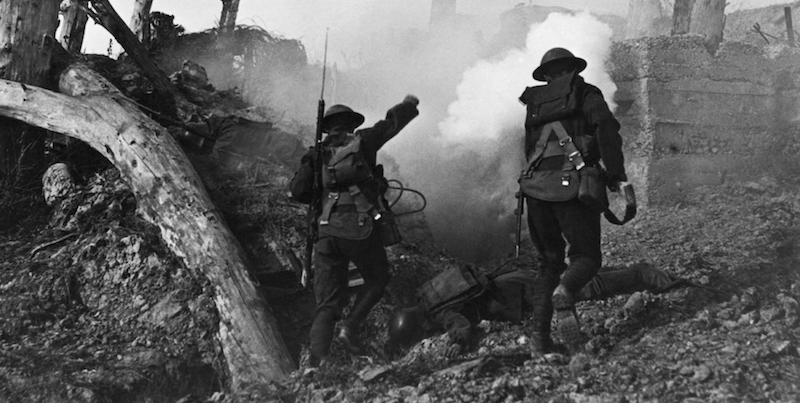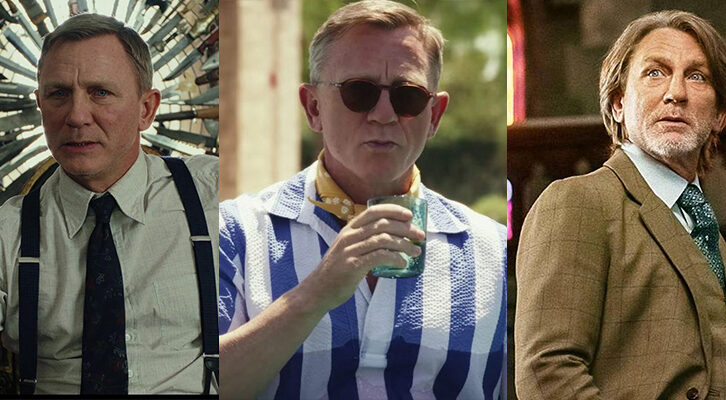Revisiting the Mental Health Fallout from the Unprecedented Horror of the First World War
Charles Glass on the Epidemic of Shell Shock
All the armies in the Great War had a word for it: the Germans called it “Kriegsneurose”; the French “la confusion mentale de la guerre”; the British “neurasthenia” and, when Dr. Charles Samuel Myers introduced the soldiers’ slang into medical discourse in 1915, “shell shock.” Twenty-five years later, it was “battle fatigue.” By the end of the twentieth century, it became post-traumatic stress disorder (PTSD).
In December 1914, a mere five months into “the war to end war,” Britain’s armed forces lost 10 percent of all frontline officers and 4 percent of enlisted men, the “other ranks,” to “nervous and mental shock.” An editorial that month in the British medical journal The Lancet lamented “the frequency with which hysteria, traumatic and otherwise, is showing itself.”
A year later, the same publication noted that “nearly one-third of all admissions into medical wards [were] for neurasthenia”—21,747 officers and 490,673 enlisted personnel. Dr. Frederick Walker Mott, director of London’s Central Pathological Laboratory, told the Medical Society of London in early 1916, “The employment of high explosives combined with trench warfare has produced a new epoch in military medical science.”
This development need not have surprised Britain’s military physicians. Major E. T. F. Birrell of the Royal Army Medical Corps (RAMC) had observed nervous breakdowns in surprising numbers while supervising a Red Cross medical mission to the Balkan Wars between Turks and Bulgarians in 1912 and 1913. The new heavy weapons that Germany’s Krupp and other European industrialists sold to both sides inflicted carnage that doctors had not witnessed before.
Modern science was creating modern war. Explosive rifle cartridges penetrated flesh more deeply than balls from single-shot muskets. High-explosive artillery shells released not only the shrapnel shards of old, but ear-shattering thunder, blinding light, and a concussion so fierce that it sucked the air away. The shells demolished the strongest ramparts, leaving no refuge. Rapid-fire machine guns mowed down hundreds of men in an instant. Hospital wards received, in addition to those who had lost arms or eyes, disabled soldiers without marks on their flesh. They suffered unexplained blindness, mutism, paralysis, shaking, and nightmares. A surgeon from Belgium’s Saint Jean Hospital, Dr. Octave Laurent, documented the Balkan wounds in his book La Guerre en Bulgarie et en Turquie. Laurent removed metal shards from broken bodies, but surgeons could not cure paralysis, trembling, nightmares, blindness, stammering, and catatonia.
Laurent posited physical causes for the symptoms. This accorded with medical and military doctrine of the day that fighting men did not become hysterical. Practitioners in the new field of psychiatry shared the view of Sigmund Freud in Vienna that hysteria, a word derived from the Greek for “uterus,” was a female condition. Laurent referred to the soldiers’ malady as la commotion cérébrospinale, a variant of what American Civil War doctors had called “windage,” undetectable molecular disruption of the spinal cord from the vibration of speeding bullets and shells. Concussion had caused some, but not all, of the neuroses. Laurent’s and the RAMC doctors’ denial of the emotional causes of physical disabilities would influence the military response to mental illness when Europe’s Great War began in the summer of 1914.
Industrial-era weaponry deployed on a mass scale from August 1914 to November 1918 exacted a greater toll in dead and wounded than in any previous war. For the first time in history, millions of men faced high-velocity bullets, artillery with previously unimaginable explosive power, modern mortar shells, aerial bombardment, poison gas, and flamethrowers designed to burn them alive. British casualties soared on August 26, 1914—a bare three weeks into the war—when German artillery ravaged the British Expeditionary Force (BEF) at Le Cateau in northeast France.
In October, the Battle of Ypres produced so many cases of mental shock that the War Office dispatched a leading neurologist, Dr. William Aldren Turner of London’s National Hospital for the Paralysed and Epileptic, to France to discover the causes. Examining otherwise healthy men afflicted by deafness, deaf-mutism, blindness, stammering, palsies, spasms, paraplegia, acute insomnia, and melancholia, he concluded, “In many instances he [the soldier] may persevere with his work until a severe psychical shock— such as seeing one of his friends killed beside him, severe shelling, an upsetting experience, or bad news from home—unsteadies him, and precipitates a definite attack of neurasthenia, requiring rest and treatment at home.”
As the war progressed, doctors recorded an escalating proportion of mental breakdowns alongside the usual statistics of killed, wounded, and missing. The percentage increased as the war froze along a static cordon of opposing trenches from the English Channel south more than four hundred miles to the border of neutral Switzerland. Along this deadly frontier, troops of both sides endured the relentless hammering of devastating artillery in a dark underground world from which the only escape was injury or death.
Debate among military physicians and between doctors and senior officers raged over how to deal with the unblooded wounded. Dr. Myers criticized the military for regarding shell-shocked soldiers as “either insane and destined for the madhouse or responsible and should be shot.” The question persisted throughout the war: should men who broke down on the field of battle be disciplined or receive medical attention?
By war’s end, firing squads had executed some, practitioners had administered punishing electric shocks to others, and psychiatrists offered Freudian psychoanalysis to a lucky few. But even then, the treatments’ purpose was to thrust shattered boys and men back into the violent conditions that had caused their breakdowns, troubling physicians who had to weigh duty to patients against military necessity.
The problem of soldiers’ mental health became a crisis in the summer of 1916, when British general Sir Douglas Haig launched an all-out assault to break the German line in northern France’s Somme Valley. Preparatory, uncamouflaged massing of forces and supplies, together with a weeklong artillery barrage to reduce enemy defenses, alerted the Germans to the impending onslaught. At 7:27 on the morning of July 1, British artillery subsided and an eerie silence prevailed. Two minutes later, a mountain of earth rocketed into the sky from a spot behind the German lines called the Hawthorn Redoubt, where British sappers detonated a 40,000-pound underground charge.
That was the signal for thousands of men laden with 66-pound backpacks to climb over the parapets of the British trenches and march into No Man’s Land. German defenders, who had sheltered deep under the surface during the barrage, emerged to fire machine guns, artillery, and mortars at their attackers. Twenty-one-year-old Captain Wilfred Nevill, known fondly as Billie to the men of his East Surrey Regiment, kicked a soccer ball onto the battlefield and charged forward. As he dribbled the ball into the barbed wire, German gunners cut him down. A fellow officer, Lieutenant Robert Eley Soames, followed with another ball, urging the men to kick it into goal. Few of them made it.
The men and boys who straggled back to their trenches had witnessed unprecedented horror. Close friends, in some cases their own brothers, had been cut to pieces before their eyes. It was more than many could bear.Novelist and official war propagandist John Buchan, whose swash-buckling imperial heroes like Richard Hannay had inspired many youngsters to volunteer, described the carnage in his 1917 book, The Battle of the Somme: “The British moved forward in line after line, dressed as if on parade; not a man wavered or broke rank; but minute by minute the ordered lines melted away under the deluge of high explosive, shrapnel, rifle, and machine-gun fire.” The Germans pitied the boys falling before their bullets, calling them Kannonenfutter, cannon fodder.
It was not combat so much as slaughter. Between dawn and dusk, nearly twenty thousand British soldiers died, while another forty thousand suffered wounds or went missing in action—the highest one-day loss in British military history before or since. The men and boys who straggled back to their trenches had witnessed unprecedented horror. Close friends, in some cases their own brothers, had been cut to pieces before their eyes. It was more than many could bear. Thousands turned up in Casualty Clearing Stations (CCS) without visible wounds but unable to speak, hear, walk, or stand still. Many were incoherent. Some, fearing terrifying nightmares, dared not sleep. They came from all ranks, a high proportion of them junior officers. Haig pressed the Somme offensive for four bloody months of mounting casualties without breaking through.
Dr. Arthur Hurst, a physician in Britain’s RAMC, filmed many of the broken men. His War Neuroses and The Battle of Seale Hayne depicted men and boys trembling, blinded, paralyzed, babbling, hiding under beds, and frozen in what Americans in Vietnam fifty years later would label “the thousand-yard stare.” Hurst’s motifs resembled those of the epoch’s silent horror movies, stricken creatures struggling with deformities, spectral figures casting sinister shadows against white backgrounds, eyes bulging and transfixed, paralyzed limbs, shaking bodies, all so terrifying that the images were not shown to the public. Although the British Army High Command was reluctant to acknowledge that war wounds could be mental as well as physical, it could not avoid addressing a phenomenon that was depriving the fighting forces of the men needed to prosecute the war.
Many of the broken men recorded their experiences in diaries, letters, illustrations, and poems. Two young officers treated for shell shock, Siegfried Sassoon and Wilfred Owen, rank among the finest poets of the war. Yet much of their verse would not have been written but for their psychotherapy. Chance brought the two poets together, and chance assigned each to a psychiatrist suited to his particular needs. These analysts acted as midwives to their works by interpreting their nightmares, clarifying their thoughts, and encouraging them in their creations.
Owen, who in another context might have been left to languish in trauma, benefited from intensive therapy under Dr. Arthur Brock. Brock’s interest in science, sociology, folklore, Greek mythology, and nature studies accorded with Owen’s. It was Brock who expanded Owen’s horizons and gave him the self-confidence to tackle sundry outside tasks and restore his mental balance. Sassoon, in contrast, enjoyed intellectual engagement with his psychiatrist, Dr. William Halse Rivers, who did not trouble him with the outside activities that Brock imposed on Owen. Had Rivers treated Owen and Brock been responsible for Sassoon, this would have been a different story. Had both young officers been sent to different hospitals, they would not have met, and the poems they wrote would have been vastly different from the masterpieces the world knows.
Following the disaster of the Somme, the War Office opened new hospitals expressly to deal with shell shock and treat what had become an epidemic. The best was a place in Scotland called Craiglockhart.
_________________________________

From Soldiers Don’t Go Mad by Charles Glass to be to be published on June 6, 2023, by Penguin Press, an imprint of Penguin Publishing Group, a division of Penguin Random House LLC. Copyright © 2023 by Charles Glass.




















